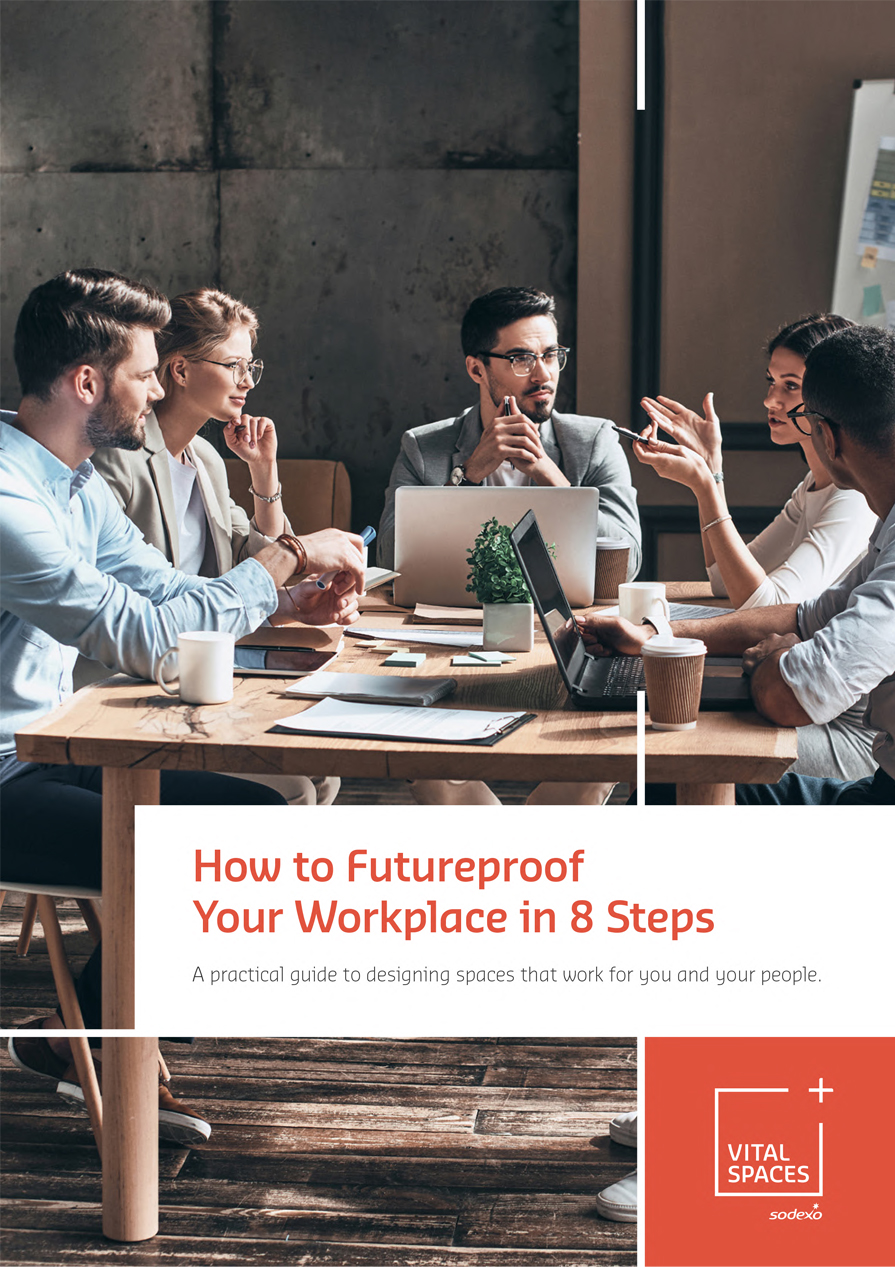The workplace has changed dramatically in the last two years, with technology enabling more remote, hybrid and flexible working. Remote working has blurred the line between work and life, shifting employee expectations of wellbeing at work. As business leaders start focusing more on employee wellbeing, what role can workplace design play?
How to Futureproof Your Workplace in 8 Step
A practical guide to designing spaces that work for you and your people.
The workplace is changing, and employees are expecting more. Companies must work harder than ever to create inspiring and optimised workplaces that invite people in and compel them to interact, socialise, connect and share.
If you’re ready to take that step, download our new guide to uncover how we can help you prepare for and embrace the new era of work.
This shift had been a long time coming, but was accelerated by the pandemic. Many people were forced to work from home, disrupting routines and causing feelings of isolation and uncertainty.
Workplace wellbeing is now moving up the agenda. It relies on organisations transforming the workplace, harnessing design and technology to promote mental and physical health. Employers that fail to act decisively risk losing the best people.
They will certainly fail to build an engaged workforce, as well as attract top talent, which will inevitably impact business performance.
This realisation is forcing an overdue change in priorities. Employers now seem to have a better understanding of health and wellbeing in the workplace, with 86% telling Sodexo’s latest UK and Ireland Worklife Continuum tracker it has become more important over the last 12 months.
But it’s not enough just to know it’s important. You need to do something about it.
Companies need a reality check (and wellbeing strategies)
As Nick Gallimore, Director of Talent, Transformation and Insight at one of the UK’s largest software companies, Advanced, says: “While it’s heartening to see that businesses do recognise the prevalence of stress and burnout among their employees, the gap between what managers believe and what employees see is a significant cause for concern.
“The consequences are clear and should be a wakeup call for employers already struggling to retain and attract the right talent.”
The link between employee wellbeing and business performance is undeniable. More than building well-being strategies, companies must embed wellness into the core design of their spaces.
Understanding the priorities and goals of an organisation is vital to designing spaces that fulfil people’s needs, which broadly cover four areas:
1. Physical wellness - from food to fitness, daylight to sleep
Employers have a clear responsibility to promote employees’ physical wellbeing. Whether that’s offering advice on fitness, sleep and good nutrition, or providing an optimal office environment which delivers sufficient natural light and fresh air.
A healthy workplace results in more dynamic and resilient workforce, as research from the World Green Building Council has proven: Increased fresh air at the workstation and a reduction in pollutants resulted in an 11% increase in employee productivity.
Even more importantly, investing in employee wellness is critical to building a workforce of healthy and happy employees, and creating a positive workplace culture.
From on-site yoga classes to personal training advice and ‘walking meetings’, there are multiple ways for companies to enhance employees’ physical wellbeing. This is particularly important now as Public Health England research found 41% of adults put on weight during the first 18 months of the pandemic.
Companies are in prime position to make a positive difference to their people’s health, with our Worklife Continuum tracker showing 55% of people planned to use workplace dining facilities just as often as they did before the pandemic when they returned to work.
Organisations must grasp the opportunity to create a space that not only offers healthy, tasty food, but which proactively brings people together.
2. Emotional health - bringing workplace wellbeing initiatives to the fore

Before the pandemic, Gartner research revealed that 45% of wellbeing budget increases were allocated to mental and emotional wellness programmes.
The fear, uncertainty and disruption caused by Covid-19 has only exacerbated this mental strain, and companies now have an even greater duty to help employees manage levels of stress by providing resources such as counselling, meditation and mindfulness.
Successful organisations will embed employee mental wellbeing as a core part of their offering. A flexible and healthy workplace environment, designed to bring the best out of employees and anticipate their needs, is key.
This is a vital aspect of Sodexo’s recently opened headquarters in central London.
Harpreet Cheema, Head of Workplace Services at Sodexo, explains: “This isn’t a space designed to come and do back-to-back calls; you can do those at home. It is designed for informal hot desking, and for people who need a mental break from their home office where their partner might also be working, and their kids might be doing their homework.”
Understanding, and providing for, mental health needs is no longer negotiable.
People will vote with their feet. As new research from Advanced shows, more than half of employees would leave their jobs in favour of organisations that can offer better support for stress and burnout.
That should be a clear wake-up call.
3. Financial support - incentives, rewards and basic advice
The PwC 2021 Employee Financial Wellbeing Survey identified finances as the top cause of employee stress - above job, health and relationships combined.
Today’s employers need to alleviate this anxiety by giving people access to financial advice, as well as providing schemes that offer financial security, such as retirement and pension plans.
Rewarding employees with bonus schemes and regular pay reviews can also ensure people feel valued and remain incentivised and motivated.
Alarmingly, many companies are failing to deliver. Research from Nudge Global in 2020 shows that just over two-thirds (67%) of employees feel unsupported by their organisation when it comes to financial wellbeing, yet 85% of employees cited financial education as extremely important to them.
Companies simply can’t afford to ignore this fundamental cry for help.
4. Social interaction - provide spaces that help people connect
The pandemic has highlighted our need for human interaction. Successful companies thrive on discussion, collaboration, interaction - all essential aspects of a positive and allied culture.
Studies by Savills, Indeed and De Montfort University all found that the opportunity to socialise with colleagues was what people who were forced to work from home missed most.

But companies now have an unprecedented opportunity to reimagine the workplace. A chance to design spaces that employees embrace, providing agile environments that can adapt quickly to different needs, and which satisfy the hunger for interaction through communal areas. Post-pandemic, ‘more collaboration space’ and ‘larger breakout space’ are two of the top four changes mentioned by employers as factors in moving their offices forward.
Beyond the physical design, events like company exercise sessions, craft workshops, remote work groups and buddy systems for new recruits can all help foster better connections.
Different approaches will work for different individuals and teams, but organisations that use space imaginatively, as well as purposefully, will stand out from the crowd.
Those that fail to seize this moment for positive change will stagnate and fade.
Do you have an employee wellbeing strategy?
The pandemic has forced employees to re-evaluate their work/life balance and their overall health. Wellness is clearly a priority. Only companies that take wellbeing seriously, and ensure that the physical working environment is designed to optimise each of the four key areas, will attract and retain the best talent in a fiercely competitive marketplace.
As Richard Holmes, Director of Wellbeing at Westfield Health, writes in HRD: “Being responsive to employee needs is certainly a trend we will be expecting to see in [2022]; gone are the days where employers put their business strategy at the forefront of all decisions. The people strategy is becoming just as, if not more, important.”
But employee wellbeing is more than a trend.
There has been a seismic shift in how we live and work, and companies only have one chance to listen, to respond, and to take the bold action demanded by the best employees.
If you’re ready to take that step, download our new guide which offers practical insight on how to design the right space to bring the best out of your workforce.
Vital Spaces
Are you ready to develop your employee wellbeing strategy?

